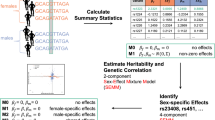Abstract
The genetic architecture of testosterone is highly distinct between sexes. Moreover, obesity is associated with higher testosterone in females but lower testosterone in males. Here, we ask whether male-specific testosterone variants are associated with a male pattern of obesity and type 2 diabetes (T2D) in females, and vice versa. In the UK Biobank, we conducted sex-specific genome-wide association studies and computed polygenic scores for total (PGSTT) and bioavailable testosterone (PGSBT). We tested sex-congruent and sex-incongruent associations between sex-specific PGSTs and metabolic traits, as well as T2D diagnosis. Female-specific PGSBT was associated with an elevated cardiometabolic risk and probability of T2D, in both sexes. Male-specific PGSTT was associated with traits conferring a lower cardiometabolic risk and probability of T2D, in both sexes. We demonstrate the value in considering polygenic testosterone as sex-related continuous traits, in each sex.
This is a preview of subscription content, access via your institution
Access options
Subscribe to this journal
Receive 12 print issues and online access
$259.00 per year
only $21.58 per issue
Buy this article
- Purchase on Springer Link
- Instant access to full article PDF
Prices may be subject to local taxes which are calculated during checkout

Similar content being viewed by others
References
Sinnott-Armstrong N, Naqvi S, Rivas M, Pritchard JK. GWAS of three molecular traits highlights core genes and pathways alongside a highly polygenic background. Elife. 2021. https://doi.org/10.7554/elife.58615.
Ruth KS, Day FR, Tyrrell J, Thompson DJ, Wood AR, Mahajan A, et al. Using human genetics to understand the disease impacts of testosterone in men and women. Nat Med. 2020;26:252–8.
Flynn E, Tanigawa Y, Rodriguez F, Altman RB, Sinnott-Armstrong N, Rivas MA. Sex-specific genetic effects across biomarkers. Eur J Hum Genet. 2021;29:154–63.
Sudlow C, Gallacher J, Allen N, Beral V, Burton P, Danesh J, et al. UK biobank: an open access resource for identifying the causes of a wide range of complex diseases of middle and old age. PLoS Med. 2015;12:1–10.
R Core Team (2020). R: a language and environment for statistical computing. Vienna, Austria: R Foundation for Statistical Computing. 2020.
Mazer NA. A novel spreadsheet method for calculating the free serum concentrations of testosterone, dihydrotestosterone, estradiol, estrone and cortisol: With illustrative examples from male and female populations. Steroids 2009;74:512–9.
Holmes D. Determine the CV of a calculated lab reportable—bioavailable testosterone. https://labrtorian.com/2017/08/07/determine-the-cv-of-a-calculated-lab-reportable-bioavailable-testosterone/.
Vermeulen A, Verdonck L, Kaufman JM. A critical evaluation of simple methods for the estimation of free testosterone in serum. J Clin Endocrinol Metab. 1999;84:3666–72.
Choi SW, Mak TSH, O’Reilly PF Tutorial: a guide to performing polygenic risk score analyses. Nat Protoc. 2020. https://doi.org/10.1038/s41596-020-0353-1.
Pasquali R. Obesity and androgens: facts and perspectives. Fertil Steril. 2006;85:1319–40.
Zeng X, Xie Yjie, Liu Yting, Long Slian, Mo Zcheng. Polycystic ovarian syndrome: Correlation between hyperandrogenism, insulin resistance and obesity. Clin Chim Acta. 2020;502:214–21.
Kelly DM, Jones TH. Testosterone and obesity. Obes Rev. 2015;16:581–606.
https://www.who.int/news-room/fact-sheets/detail/diabetes. 2020.
Betancourt-Albrecht M, Cunningham GR. Hypogonadism and diabetes. Int J Impot Res. 2003;15:14–20.
Andersson B, Marin P, Lissner L, Vermeulen A, Bjorntorp P. Testosterone concentrations in women and men with NIDDM. Diabetes Care. 1994. https://doi.org/10.2337/diacare.17.5.405.
Haider A, Yassin A, Haider KS, Doros G, Saad F, Rosano GMC. Men with testosterone deficiency and a history of cardiovascular diseases benefit from long-term testosterone therapy: observational, real-life data from a registry study. Vasc Health Risk Manag. 2016;12:251–61.
Traish AM, Haider A, Haider KS, Doros G, Saad F. Long-term testosterone therapy improves cardiometabolic function and reduces risk of cardiovascular disease in men with hypogonadism. J Cardiovasc Pharmacol Ther. 2017;22:414–33.
Haider KS, Haider A, Saad F, Doros G, Hanefeld M, Dhindsa S, et al. Remission of type 2 diabetes following long-term treatment with injectable testosterone undecanoate in patients with hypogonadism and type 2 diabetes: 11-year data from a real-world registry study. Diabetes, Obes Metab. 2020;22:2055–68.
Wittert G, Bracken K, Robledo KP, Grossmann M, Yeap BB, Handelsman DJ, et al. Testosterone treatment to prevent or revert type 2 diabetes in men enrolled in a lifestyle programme (T4DM): a randomised, double-blind, placebo-controlled, 2-year, phase 3b trial. Lancet Diabetes Endocrinol. 2021;9:32–45.
Vosberg DE, Syme C, Parker N, Richer L, Pausova Z, Paus T. Sex continuum in the brain and body during adolescence and psychological traits. Nat Hum Behav. 2021;5:265–72.
Acknowledgements
This research has been funded by the Canadian Institutes of Health Research, Heart and Stroke Foundation of Canada, Canadian Foundation for Innovation, and National Institutes for Health. The research has been conducted using the UK Biobank Resource under Application Number 43688. The corresponding author, Dr. Tomáš Paus, is the guarantor.
Author information
Authors and Affiliations
Contributions
DEV contributed to the project conception, analyses, figure, and manuscript writing and revision. NP and JS contributed to the analyses and manuscript revision. ZP and TP contributed to the project conception and manuscript writing and revision. All authors approved the final version and are accountable for the work.
Corresponding author
Ethics declarations
Competing interests
The authors declare no competing interests.
Additional information
Publisher’s note Springer Nature remains neutral with regard to jurisdictional claims in published maps and institutional affiliations.
Supplementary information
Rights and permissions
About this article
Cite this article
Vosberg, D.E., Parker, N., Shin, J. et al. The genetics of testosterone contributes to “femaleness/maleness” of cardiometabolic traits and type 2 diabetes. Int J Obes 46, 235–237 (2022). https://doi.org/10.1038/s41366-021-00960-w
Received:
Revised:
Accepted:
Published:
Issue Date:
DOI: https://doi.org/10.1038/s41366-021-00960-w



